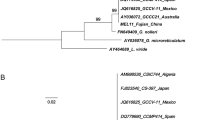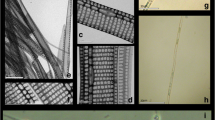Abstract
A clonal culture of a Vietnamese strain of Alexandrium minutum, AlexSp17, was subjected to different salinity treatments to determine the growth and toxin production of this strain that produces a novel toxin analogue, deoxy GTX4-12ol. The experiment was carried out in batch cultures without pre-acclimatization at seven salinity treatments from 5 to 35 psu, under constant temperature of 25°C, illumination of 140 μmol photon m−2 s−1, and 12:12 light/dark photoperiod. The strain grew in all salinity treatments, with optimum growth at 10–15 psu. However, the specific growth rate (0.2 day−1) was lower than those reported in Malaysian strains and other strains from different geographical areas. The optimum range of salinity for the growth of this species agreed with field observations of the locality of origin. No significant change in toxin profiles was observed at different salinities. The cellular toxin quota, Qt, was not affected by the salinity-dependent growth rate. The toxin GTX4-12ol is presumed to be a transformation product of GTX4 from specific cellular reductase enzymes. Further investigation at the molecular level of toxin biosynthesis and subcellular enzyme activities is needed to provide insight in the production of this unique toxin analogue.





Similar content being viewed by others
References
Anderson DM (1998) Physiology and bloom dynamics of toxic Alexandrium species, with emphasis on life cycle transitions. In: Anderson DM, Cembella AD, Hallegraeff GM (eds) Physiological ecology of harmful algal blooms. Springer, Berlin, pp 29–48
Anderson DM, Kulis DM, Sullivan JJ, Hall S, Lee C (1990) Dynamics and physiology of saxitoxin production by the dinoflagellates Alexandrium spp. Mar Biol 104:511–524
Asakawa M, Tagaki M, Iida A, Ioshi M (1987) Studies on the conversion of paralytic shellfish poison (PSP) components by biochemical reducing agents. Eisei Kagaku 33:50–55
Boyer GL, Sullivan JJ, Andersen RL, Harrison PJ, Taylor FJR (1987) Effects of nutrient limitation on toxin production and composition in the marine dinoflagellate Protogonyaulax tamarensis. Mar Biol 96:123–128
Cannon JE (1993) Growth in culture of the toxic dinoflagellate Alexandrium minutum from the Port River, South Australia. In: Smayda TJ, Shimizu Y (eds) Toxic phytoplankton blooms in the sea. Elsevier, New York, pp 741–745
Cembella AD, Therriault JC (1989) Population dynamics and toxin composition of Protogonyaulax tamarensis from the St. Lawrence Estuary. In: Okaichi T, Anderson DM, Nemoto T (eds) Red tides—biology, environmental science and toxicology. Elsevier, New York, pp 81–85
Cembella AD, Therriault JC, Beland P (1988) Toxicity of cultured isolates and natural populations of Protogonyaulax tamarensis from the St. Lawrence Estuary. J Shellfish Res 7:611–621
Chang FH, McClean M (1997) Growth responses of Alexandrium minutum (Dinophyceae) as a function of three different nitrogen sources and irradiance. N Z J Mar Freshw Res 31:1–7
Chang FH, Anderson DM, Kulis DM, Till DG (1997) Toxin production of Alexandrium minutum (Dinophyceae) from the Bay of Plenty, New Zealand. Toxicon 35:393–409
de Salas MF, van Emmerick MJ, Hallegraeff GM, Negri AP, Vaillancourt RE, Bolch CJ (2001) Toxic Australian Alexandrium dinoflagellates: introduced or indigenous? In: Hallegraeff GM, Bolch CJ, Lewis RJ (eds) Harmful algal blooms 2001. IOC of UNESCO, Rome, pp 214–217
Flynn K, Jones KJ, Flynn KJ (1996) Comparisons among species of Alexandrium (Dinophyceae) grown in nitrogen- or phosphorus-limiting batch culture. Mar Biol 126:9–18
Giacobbe MG, Oliva FD, Maimone G (1996) Environmental factors and seasonal occurrence of the dinoflagellate Alexandrium minutum, a PSP potential producer, a Mediterranean lagoon. Estuar Coast Shelf Sci 42:539–549
Grzebyk D, Bechemin C, Ward CJ, Verite C, Codd GA, Maestrini SY (2003) Effects of salinity and two coastal waters on the growth and toxin content of the dinoflagellate Alexandrium minutum. J Plankton Res 25:1185–1199
Hamasaki K, Horie M, Tokimitsu S, Toda T, Taguchi S (2001) Variability in toxicity of the dinoflagellate Alexandrium tamarense isolated from Hiroshima Bay, western Japan, as a reflection of changing environmental conditions. J Plankton Res 23:271–278
Hansen G, Daugbjerg N, Franco JM (2003) Morphology, toxin composition and LSU rDNA phylogeny of Alexandrium minutum (Dinophyceae) from Denmark, with some morphological observations on other European strains. Harmful Algae 2:317–335
Hwang DF, Lu YH (2000) Influence of environmental and nutritional factors on growth, toxicity, and toxin profile of dinoflagellate Alexandrium minutum. Toxicon 38:1491–1503
John EH, Flynn KJ (2002) Modelling changes in paralytic shellfish toxin content of dinoflagellates in response to nitrogen and phosphorus supply. Mar Ecol Prog Ser 225:147–160
Kellmann R, Mihali TK, Jeon YJ, Pickford R, Pomati F, Neilan BA (2008) Biosynthetic intermediate analysis and functional homology reveal a saxitoxin gene cluster in cyanobacteria. Appl Environ Microbiol 74:4044–4053
Kodama M (2000) Ecobiology, classification, and origin. In: Botana LM (ed.) Seafood and freshwater toxins‐pharmacology, physiology, and detection. Marcel Dekker, New York, pp 125‐149
Kokinos JP, Anderson DM (1995) Morphological development of resting cysts in cultures of the marine dinoflagellate Lingulodinium polyedrum (= L. machaerophorum). Palynology 19:143–166
Lim PT, Ogata T (2005) Salinity effect on growth and toxin production of four tropical Alexandrium species (Dinophyceae). Toxicon 45:699–710
Lim PT, Leaw CP, Usup G (2004) First incidence of paralytic shellfish poisoning on the east coast of Peninsular Malaysia. In: Phang SM, Chong VC, Ho SS, Mokhtar N, Ooi JLS (eds) Marine science into the new millennium: new perspectives and challenges. University of Malaya Maritime Research Centre, Kuala Lumpur, pp 661–667
Lim PT, Leaw CP, Usup G, Kobiyama A, Koike K, Ogata T (2006) Effects of light and temperature on growth, nitrate uptake, and toxin production of two tropical dinoflagellates: Alexandrium tamiyavanichii and Alexandrium minutum (Dinophyceae). J Phycol 42:786–799
Lim PT, Sato S, Van Thuoc C, Tu PT, Huyen NTM, Takata Y, Yoshida M, Kobiyama A, Koike K, Ogata T (2007a) Toxic Alexandrium minutum (Dinophyceae) from Vietnam with new gonyautoxin analogue. Harmful Algae 6:321–331
Lim PT, Leaw CP, Ogata T (2007b) Morphological variation of two Alexandrium species responsible for paralytic shellfish poisoning in Southeast Asia. Bot Mar 50:14–21
Llewellyn L, Negri A, Quilliam M (2004) High affinity for the rat brain sodium channel of newly discovered hydroxybenzoate saxitoxin analogues from the dinoflagellate Gymnodinium catenatum. Toxicon 43:101–104
Matsuoka K, Fukuyo Y, Yoshida M (1997) Alexandrium minutum Halim collected from aquaculture ponds in tropical and subtropical coastal waters. In: Sudara S (ed) Marine conservation and resource rehabilitation. Chulalongkorn University, Chiangrai, pp 85–94
Ogata T, Kodama M, Ishimaru T (1989) Effect of water temperature and light intensity on growth rate and toxin production of toxic dinoflagellates. In: Okaichi T, Anderson DM, Nemoto T (eds) Red tides: biology, environmental science, and toxicology. Elsevier, New York, pp 423–426
Onodera H, Satake M, Oshima Y, Yasumoto T, Carmichael WW (1997) New saxitoxin analogues from the freshwater filamentous cyanobacterium Lyngbya wollei. Nat Toxins 5:146–151
Oshima Y (1995) Postcolumn derivatization liquid chromatography method for paralytic shellfish toxins. J AOAC Int 78:528–532
Parkhill JP, Cembella AD (1999) Effects of salinity, light and inorganic nitrogen on growth and toxigenicity of the marine dinoflagellate Alexandrium tamarense from northeastern Canada. J Plankton Res 21:939–955
Sako Y, Yoshida T, Uchida A, Arakawa O, Noguchi T, Ishida Y (2001) Purification and characterization of a sulfotransferase specific to N-21 of saxitoxin and gonyautoxin 2+3 from the toxic dinoflagellate Gymnodinium catenatum (Dinophyceae). J Phycol 37:1044–1051
Shimizu Y, Gupta S, Norte M, Hori A, Genenah A, Kobayashi M (1985) Biosynthesis of paralytic shellfish toxins. In: Anderson DM, White AW, Baden DG (eds) Toxic dinoflagellates. Elsevier, New York, pp 271–274
Turner JT, Tester PA, Hansen PJ (1998) Interactions between toxic marine phytoplankton and metazoan and protistan grazer. In: Anderson DM, Cembella AD, Hallegraeff GM (eds) Physiological ecology of harmful algal blooms. Springer, Berlin, pp 453–474
Usup G, Leaw CP, Ahmad A, Lim PT (2002) Alexandrium (Dinophyceae) species in Malaysian waters. Harmful Algae 1:265–275
Wang D, Hsieh DPH (2001) Dynamics of C2 toxin and chlorophyll-a formation in the dinoflagellate Alexandrium tamarense during large scale cultivation. Toxicon 39:1533–1536
White AW (1978) Salinity effects on growth and toxin content of Gonyaulax excavata, a marine dinoflagellate causing paralytic shellfish poisoning. J Phycol 14:475–479
Yoshida M, Ogata T, Thuoc CV, Matsuoka K, Fukuyo Y, Hoi NC, Kodama M (2000) The first finding of toxic dinoflagellate Alexandrium minutum in Vietnam. Fish Sci 66:177–179
Acknowledgments
P. T. Lim was supported by UNIMAS and the Malaysian Government through FRGS grant. The work was partially funded through Grant-in Aid for the Scientific Researches from Ministry of Education and Science and Technology Japan to T. Ogata, and the National Project on HAB of Vietnam (KC-09-19) to C.V. Thuoc. This is a regional collaborative research funded by Multilateral Cooperative Research Program for JSPS.
Author information
Authors and Affiliations
Corresponding author
Rights and permissions
About this article
Cite this article
Lim, P.T., Leaw, C.P., Sato, S. et al. Effect of salinity on growth and toxin production of Alexandrium minutum isolated from a shrimp culture pond in northern Vietnam. J Appl Phycol 23, 857–864 (2011). https://doi.org/10.1007/s10811-010-9593-8
Received:
Revised:
Accepted:
Published:
Issue Date:
DOI: https://doi.org/10.1007/s10811-010-9593-8




